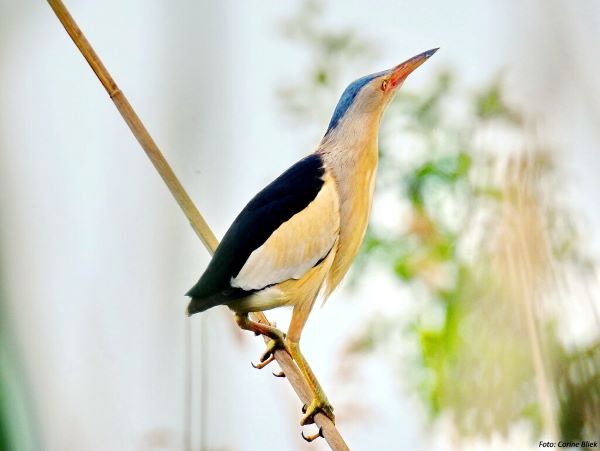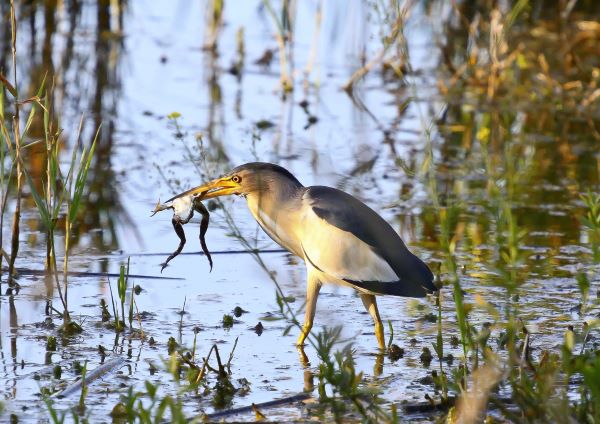Family: The minute bittern (Ixobrychus minutus) is a member of the heron family Ardeidae in the genus Ixobrychus.
Identification: The male minute bittern has black over the crown, back, wings, and tail; the neck is rufous, and the shoulders are ochre-buff. The undersurface is light cinnamon-brown to white, with dusky streaks on the neck and sides of the breast. The skin on the face is yellow. The eyes are yellow. The bill is green-yellow with black culmen. Legs and feet are green-grey, with a yellow stripe behind. Face skin, eye, and base of bill red during breeding.
The female minute bitter has a streak of dark buff and brown. Compared to the male, the female’s bird wing panel is less noticeable. However, the immature bird has an Ochreish buff, heavily streaked dusky eyes, and a light brown bill. The legs and feet are yellow-olive. Moreover, the downy young have hairy rufous above and white below.

Habitat: Minute Bittern is rarely seen. It lives in dense swampy reed beds, clambering about adeptly mainly at night for insects and small vertebrates. Males begin the nest, but both parents incubate and greet each other with mellow calls and sparring, their crown feathers raised. Both also feed the young through regurgitation. When disturbed, young people also ‘freeze’ with bills pointing upwards. Within eight days, they begin to clamber out of the nest and fly after several weeks. Its petite stature, long, sharp bill, and thick neck define it as the smallest breeding heron in Europe.
Nesting and Breeding: The minute bittern nesting and breeding occur in October–December. Nest 10–40 cm above the water on a flimsy pad of reeds and rushes. The monogamous pair stays together for at least one breeding season after the male bird establishes a territory in the spring and announces his arrival with a harsh barking or croaking cry.
Eggs and Incubation: This bittern lays 4–7 eggs, white and oval, about 30 x 25 mm. There is only one brood each year, and eggs are laid in a nest that is located above the water in dense reedbeds, rushes, or bushes starting in mid-May. The incubation period is about 17–19 days for both sexes. Young fledge in about four weeks.
Distribution: Minute bitterns are usually found near freshwater reed beds in eastern and southwestern Australia and New Guinea. Regionally nomadic. Minute bitterns are found in temperate regions of Europe and western Asia. A migratory bird rests while wintering in Africa and further south in Asia, breeding in Madagascar, central and southern Europe, western and southern Asia, and Africa.
Vocalizations: The minute bittern sound is deep, repeated croaks and croons at the nest. Sharp bark in alarm calls.
Migrations: The little bittern is a migratory species in Europe, having migrated as far south as the Eastern Cape and Transvaal. It crosses the Mediterranean from Africa in the early spring and arrives in their breeding wetlands from mid-April onward. It returns to Africa in August and September, with only a few juveniles remaining in Europe by October, on average.
Diet: The minute bittern is a crepuscular, skulking, and largely solitary bird that feeds on fish, amphibians, and insects that it catches by pursuing its prey slowly through reedbeds or along their borders. It feeds alone, defending its feeding territory, and freezes like a stick to conceal itself.
Taxonomy: In 1766, the little bittern was first described by ornithologists Carl Linnaeus. A reed-like plant called ixobrychus is derived from the Ancient Greek brukhomai, which means “to bellow,” and minutus, which means “little” in Latin.
Other Names: This bird is also known as Kaoriki, Common Little Bittern, and Little Bittern.
Size: Little bittern measures about 285–340 mm in length with a wing span of 52–58 cm.
Races: There are about 4 races; however, only one is found in Australia.
-
m. minutus: This is found in Asia, Europe, and Africa.
-
m. payesii: A resident bird of sub-Saharan Africa
-
m. Podiceps: A resident bird found in Madagascar
-
I. dubius: found in Australia and New Zealand. Also note that I. novaezelandiae was previously considered a subspecies of the little bittern.

The minute bittern (Ixobrychus minutus) is a member of the heron family Ardeidae in the genus Ixobrychus.






